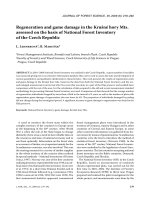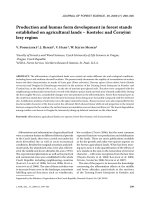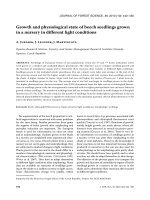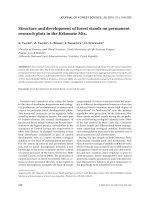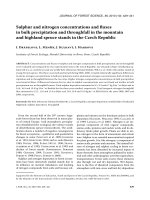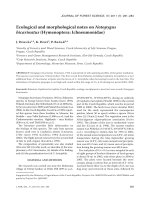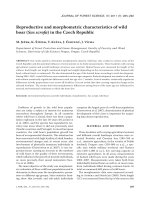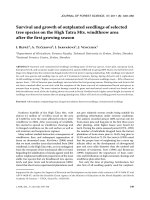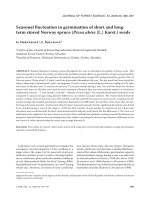Báo cáo lâm nghiệp: "Physiological and morphological responses of dormant and growing Norway spruce container seedlings to drought after planting" docx
Bạn đang xem bản rút gọn của tài liệu. Xem và tải ngay bản đầy đủ của tài liệu tại đây (258.9 KB, 7 trang )
201
Ann. For. Sci. 62 (2005) 201–207
© INRA, EDP Sciences, 2005
DOI: 10.1051/forest:2005011
Original article
Physiological and morphological responses of dormant and growing
Norway spruce container seedlings to drought after planting
Pekka HELENIUS*, Jaana LUORANEN, Risto RIKALA
Finnish Forest Research Institute, Suonenjoki Research Station, Juntintie 154, 77600 Suonenjoki, Finland
(Received 17 March 2004; accepted 30 September 2004)
Abstract – Survival, root egress, height growth, xylem water potential, and chlorophyll fluorescence of dormant and growing Norway spruce
(Picea abies (L.) Karst.) container seedlings exposed to postplanting drought periods (1, 2, 3 and 4 weeks) in the field were studied. Growth
stages were created by terminating overwinter frozen storage 5 weeks (growing) or 5 days (dormant) before planting. Without postplanting
drought, root egress of growing seedlings during the 6-week study period was twice that of dormant seedlings. When exposed to postplanting
drought, growing seedlings showed a greater decline in root egress and xylem water potential than dormant seedlings. Postplanting drought had
no effect on chlorophyll fluorescence in dormant seedlings, whereas in growing seedlings chlorophyll fluorescence decreased after the 3-week
drought period. The results indicate that planting seedlings kept dormant by prolonged frozen storage in summer is beneficial only if very long
dry periods occur after planting.
chlorophyll fluorescence / drought / growth stage / Picea abies / root egress
Résumé – Réaction physiologique et morphologique à la sécheresse après plantation de semis dormants ou en croissance de Picea abies
cultivés en conteneurs. La survie, la production de nouvelles racines, la croissance de la pousse, le potentiel hydrique du xylème et la
fluorescence de la chlorophylle ont été étudiés sur des semis de Picea abies (L.) Karst, dormants ou en croissance, cultivés en conteneurs et
exposés à des périodes (1, 2, 3 et 4 semaines) de sécheresse après plantation au champ. Pour préparer les divers stades de croissance, le stockage
hivernal des semis au froid a cessé 5 semaines (en croissance) ou 5 jours (dormants) avant la plantation. Quand les semis n’ont pas été exposés
à la sécheresse après plantation, la production de nouvelles racines des semis en croissance a doublé comparativement aux semis dormants
pendant les 6 semaines d’étude. Pour les semis exposés à la sécheresse après plantation, la production de nouvelles racines et le potentiel
hydrique ont davantage baissé pour les semis en croissance que pour les semis dormants. La sécheresse après plantation n’a pas affecté la
fluorescence de la chlorophylle des semis dormants, mais après une sécheresse de 3 semaines la fluorescence de la chlorophylle des semis en
croissance a baissé. Les résultats montrent que la plantation des semis qui ont été conservés dormants par un stockage au froid plus long en été
est bénéfique dans le cas où la sécheresse continue très longtemps après plantation.
fluorescence de la chlorophylle / sécheresse / stade de croissance / Piceas abies / production de nouvelles racines
1. INTRODUCTION
Nearly 150 million container-grown conifer seedlings,
mostly Norway spruce (Picea abies (L.) Karst.), are annually
delivered for planting in Finland (Finnish Ministry of Agricul-
ture and Forestry, 2003). At present more than 30% of the seed-
lings are frozen stored. Seedlings are usually planted in three
or four weeks in May before shoots start to elongate and soil
is considered too dry for survival and growth. However, during
the last 20 years the number of workers employed in silvicul-
tural work, e.g. in planting, has decreased almost 50% [7], and
it is predicted that the decrease will continue in the near future.
Hence, planting all the seedlings with a decreasing number of
workers necessitates an extended planting period. Moreover,
extended planting period would ease spring workloads in nurs-
eries and enable profitable mechanized planting. Therefore,
producing planting material for an extended planting period
requires rescheduling of the plant production chain to be able
to grow morphologically and physiologically target seedlings
for each time and site.
A major impediment to the extension of the spring planting
period is the risk of drought. If the summer is warm, and if the
precipitation and capillary rise of water from deeper soil layers
are insufficient to compensate for transpiration, newly planted
* Corresponding author:
Article published by EDP Sciences and available at or />202 P. Helenius et al.
seedlings with restricted root systems are susceptible to water
stress. In addition, seedlings that have been stored traditionally
outdoors under snow cover, which usually persists until the end
of April in central Finland, are already actively growing in June.
Although they have high ability to root egress, their resistance
against a number of stresses (e.g. drought, frost, mechanical
stress, etc.) is low [4, 5, 26]. For example, the field performance
of growing Norway spruce container seedlings has been shown
to be reduced after a 2-week drought period in warm weather
[14]. Because drought periods lasting longer than two weeks
occur in summer in Finland (based on the meteorological data-
base at the Suonenjoki Research Station of Finnish Forest
Research Institute), planting growing seedlings in summer may
result in plantation failure especially if soil is dry at the time
of planting.
Since the stress resistance is closely related to the phenolog-
ical stage of seedlings [3, 8], it should be possible to decrease
the risk of plantation failure due to drought in early summer by
planting dormant or short-day treated seedlings instead of
growing ones. However, due to the late start of the growing sea-
son at northern latitudes, short-day treatment cannot be applied
economically to produce hardened seedlings yet for June plant-
ing. Dormancy, instead, can be maintained until the time of the
planting by prolonged overwinter frozen storage. Provided that
seedlings coming-out-of-dormancy perform better under
drought than growing seedlings, successful extension of the
planting period would only be a matter of scheduling the deliv-
ery of frozen-stored seedlings later than that of outdoor-stored
seedlings.
In central Finland frozen storage can be prolonged at most
until mid-June without the risk of frost damage to seedlings in
autumn [10, 22]. Since the frozen storage of spring planted
seedlings is usually initiated in October, prolongation would
account for a storage period of over 30 weeks. Long storage
periods may, however, affect the postplanting performance,
especially if seedlings are exposed to water stress after planting
[12, 16, 17]. In addition, dormant seedlings initiating new
growth after planting allocate preferentially more photosynt-
hates to shoot growth compared to root growth [8], which may
reduce the ability to maintain balanced seedling water relations
when exposed to drought. Besides the obvious effect on seed-
ling water relations (whether seedlings are dormant or grow-
ing), drought may also affect needle chlorophyll fluorescence
[1], and when severe and long-lasting, also growth and survival.
The aim of this study was to determine if the risk of planta-
tion failure due to drought in early summer could be decreased
by planting dormant seedlings after prolonged frozen storage
instead of growing seedlings from the same seedling stock. To
achieve this aim, we compared physiological and morpholog-
ical responses of dormant and growing seedlings to postplant-
ing drought under experimental field conditions.
2. MATERIALS AND METHODS
2.1. Seedling material
Norway spruce seeds obtained from a registered seed orchard
(No. 113, Kangasniemi 61° 54’ N, 26° 40’ E, 100 m a.s.l.) were sown
on hard plastic containers (Plantek 81F, Lannen, Co., Finland; cell
volume 85 cm
3
) filled with base-fertilized sphagnum peat (Kekkila
Co., Finland) on 20 April 2001. Seedlings were grown in a greenhouse
at the Suonenjoki Research Nursery (62° 39’ N, 27° 03’ E, 142 m a.s.l.)
until 16 July, when they were transferred to an outdoor growing area.
During the first growing season, seedlings were irrigated regularly to
keep the water content of peat at 40-50% (v v
–1
; by volume), and they
were fertilized altogether 18 times between 14 June and 12 September
with liquid Taimi-superX fertilizer (Kekkila Co., Finland) (a total of
54 mg N, 14 mg P and 57 mg K per seedling plus micronutrients). On
23 October 2001, seedlings were extracted from the containers and
placed upright in plastic trays (490 mm × 290 mm × 70 mm, 63 seed-
lings per tray) that were inserted into cardboard boxes (2 trays per box).
Two dataloggers (HOBO, Pro Series, USA) were inserted in randomly
selected boxes to record temperature and relative humidity during stor-
age. Boxes were then transferred to frozen storage (–3.5 °C). The tem-
perature inside the boxes decreased from 7 °C (outdoor temperature)
to –3.4 °C in 23 days. Thereafter, the temperature varied between
–2.4 and –5.3 °C (mean –3.5 °C) and relative humidity between 96.7
and 99.9% (mean 98.3%) during the rest of the storage period.
On 20–24 May 2002, after 30 weeks, half of the seedling stock (five
boxes) were removed from the frozen storage (one box per day) and
thawed at +12 °C in the dark for 3 days. After thawing, seedlings were
taken out of the boxes and acclimated to light in an outdoor shelter for
2 days (the shelter shaded 89% of the photosynthetically active radi-
ation, PAR). Seedlings were returned to the containers and transferred
to the outdoor growing area, where they were grown under normal
nursery culture regime until the beginning of the experiment. Seed-
lings were irrigated regularly and fertilized three times with liquid
Taimi-superX fertilizer (a total of 12 mg N, 2.5 mg P and 13 mg K
per seedling plus micronutrients) in order to avoid any decrease in
seedling nutrient concentration before the experiment. These seed-
lings are referred to below as growing seedlings. The rest of the seed-
lings (five boxes) were kept in the frozen storage until 19–23 June 2002
(frozen storage duration 34 weeks), when they were likewise removed
from storage, thawed, acclimated to light and returned to the containers
as described above. These seedlings are referred to below as dormant
seedlings. Seedling morphology at the beginning of the experiment
(24 June) is given in Table I.
To measure possible carbohydrate depletion during the 4-week
prolongation of the frozen storage, needle samples were collected on
three occasions: (I) 23 October 2001, before the seedlings were placed
into frozen storage, (II) 20–22 May 2002, after the 30-week storage
(growing seedlings) and (III) 19–21 June 2002, after the 34-week stor-
age (dormant seedlings). On each occasion, 15 seedlings were ran-
domly selected and divided into three groups (subsamples). From each
seedling, 15 needles were collected from the middle section of the
shoot, dried at 60 ºC for 72 h and powdered. The samples were
extracted and soluble sugars and starch were analyzed as described by
Hansen and Møller
[11] and Iivonen et al. [15]. The concentration of
Table I. Morphological attributes (mean ± SD) of subsamples (n =
40) of dormant and growing seedlings at the beginning of the experi-
ment (24 June).
Attribute
Dormant
seedlings
Growing
seedlings
Height (cm) 19.1 ± 2.1 28.3 ± 2.6
Stem diameter (mm) 2.6 ± 0.3 3.4 ± 0.4
Shoot dry weight (g) 1.04 ± 0.19 1.94 ± 0.43
Root dry weight (g) 0.43 ± 0.10 0.51 ± 0.11
Root to shoot ratio 0.41 0.26
Article published by EDP Sciences and available at or />Responses of Picea abies to drought 203
soluble sugars in needles were 146.0 ± 3.4, 110.4 ± 2.4 and 115.0 ±
4.0 mg g
–1
dry weight (mean ± SD) and the concentration of starch
were 33.0 ± 1.0, 33.7 ± 1.0 and 30.7 ± 1.7 mg g
–1
dry weight (mean ±
SD) on the first, second and third sampling date, respectively.
2.2. Experimental design
Root egress and height growth were studied by exposing dormant
and growing seedlings to different postplanting drought periods (0, 1,
2, 3 and 4 weeks) on a sandy experimental field site. To homogenize
soil conditions, vegetation cover and organic layer were removed from
the field site. The percentages of the dominant particle size (0.2–
0.6 mm) in the site varied between 65 and 72. The soil was free from
clay material, and the content of organic matter was low (loss of igni-
tion at 550 °C for 3 h ranged from 0.8 to 1.8%). Water-retention char-
acteristics of the soil in the field site are presented in Heiskanen and
Rikala
[13]. The site (10 × 30 m) was covered with a plastic rain shel-
ter placed at a height of about 2 m. The shelter shaded ~ 35% of PAR
measured at ground level (LI-COR LI-185B quantum sensor). Ran-
domly selected seedlings were well-watered and new roots grown out
from the root plug were cut. Then the seedlings were planted under
the rain shelter in a split-plot design consisting of five blocks divided
into five plots (one plot for each postplanting drought period). In each
plot there were subplots of 15 dormant and 15 growing seedlings in a
grid measuring 25 × 25 cm (a total of 750 seedlings: 5 blocks ×
5 drought periods × 2 subplots × 15 seedlings). As seedlings were
removed from the frozen storage and thawed on 5 consecutive days,
the blocks (No. 1–5) were likewise planted in numerical order on
5 consecutive days (24, 25, 26, 27 and 28 June). Postplanting drought
periods were created in plots by withholding irrigation for either 0, 1,
2, 3 or 4 weeks. After drought periods, plots were irrigated manually
with 15 mm tapwater twice a week so that the drought period plus irri-
gation lasted 6 weeks (i.e. 1-week drought period + 5 weeks irrigation,
etc.). The combination of drought period and irrigation is referred to
below as the study period. Control plots (0-week drought period) were
irrigated from the beginning of the experiment. To ascertain the avail-
ability of water to seedlings after drought periods, the amount of irri-
gation given (15 mm twice a week) was somewhat higher than the
mean weekly precipitation in July in central Finland.
Shoot xylem water potential (Ψ
shoot
) and needle chlorophyll fluo-
rescence of dormant and growing seedlings were studied before plant-
ing and after four postplanting drought periods (1, 2, 3 and 4 weeks)
on the same experimental field site as root egress and height growth.
On 25 June, additional 100 dormant and growing seedlings were ran-
domly selected from the seedling stock. Of these, 80 well-watered
seedlings from both groups were planted in a separate block (No. 6)
on 26 June. The block consisted of four plots, each having 20 dormant
and 20 growing seedlings receiving no irrigation. The remaining
20 seedlings in both groups were reserved for measurement of pre-
planting Ψ
shoot
and chlorophyll fluorescence.
2.3. Measurements
2.3.1. Survival, root egress and height growth
After the 6-week study period, seedlings in blocks 1-5 were lifted
and visually rated as dead or alive by the presence or absence of turgid
green needles. Extensive root damage caused by summer chefer larvae
(Amphimallon solstitiale L.) was observed in 9 dormant and 5 growing
seedlings, most of them in block 4. These seedlings were excluded
from further measurements and analysis. Height growth of surviving
seedlings was determined (± 1 mm) on the basis of the difference
between initial height and final height (both measured from the surface
of the root plug to the terminal bud or terminal meristem). Roots that
had grown out from the root plug (root egress) of surviving seedlings
were cut, washed and dried in an oven (48 h at 105 °C) and weighed
(± 1 mg).
2.3.2. Shoot xylem water potential and needle
chlorophyll fluorescence
On 25 June, 20 dormant and 20 growing seedlings reserved for
measurement of preplanting values of Ψ
shoot
and chlorophyll fluores-
cence were transferred in containers to the field site and placed on the
ground next to block No. 6. At northern latitudes nights are short and
light in July. To eliminate possible variation in Ψ
shoot
due to weather
conditions (clear or cloudy sky) during the nights preceding the meas-
urements, the containers were covered at 2200 h with a black cloth
(LS-100) wrapped over a wooden frame (130 × 150 × 44 cm) to create
an artificial night. Photon flux density of PAR under the frame was
0.25 µmol m
–2
s
–1
measured at 1000 µmol m
–2
s
–1
(LI-COR LI-185B
quantum sensor). The frame was removed at 0500 h the next morning
and 10 seedlings from both groups (dormant + growing) were trans-
ferred to the laboratory in a cool bag. In the laboratory, the seedling
shoots were excised 4–8 cm below the terminal bud scar and measured
for simulated predawn xylem water potential (Ψ
shoot pd
) using a pres-
sure chamber [27]. Another 10 seedlings from both groups were trans-
ferred to the laboratory at 1400 h and measured for daytime xylem
water potential (Ψ
shoot d
). After daytime measurement, previous year
needle chlorophyll fluorescence of the same seedlings from both
groups was measured with a MINI-PAM fluorometer (Heinz Walz
GmbH, Effeltrich, Germany). From each seedling, 15 needles were col-
lected below the excision point and dark adapted at room temperature
for 35 min before fluorescence was measured using a 1-s saturating
pulse of 9000 µmol m
–2
s
–1
. The ratio of variable (F
v
) to maximal (F
m
)
chlorophyll fluorescence was used as a quantitative measure of the
photochemical efficiency of the photosystem II (PS II). Xylem water
potential (Ψ
shoot pd
and Ψ
shoot d
) and chlorophyll fluorescence meas-
urements were repeated, as described above, after 1-, 2-, 3- and 4-week
drought periods using the seedlings planted in block No. 6. Blackout
(artificial night) was used only during the nights preceding the meas-
urements.
2.4. Weather and edaphic conditions
Air temperature and relative humidity at the field site were moni-
tored during the study period using a thermohygrograph (Lambrecht,
West Germany) placed in a weather cabin at the soil surface level
(Tab. II). Midsummer 2002 was slightly warmer than the 30-yr aver-
age (1972–2001) at the Suonenjoki Research Station. The mean tem-
perature during the study period (24 June–9 August) was 0.6 ºC above
Table II. Mean weekly temperature (° C) and relative humidity (%)
at the soil surface level during the study period.
Week Temp. (ºC) RH (%)
24–30 June 13.9 74.4
01–07 July 17.0 69.3
08–14 July 21.2 52.1
15–21 July 20.5 62.5
22–28 July 19.3 61.3
29 July–04 August 20.2 51.3
05–11 August 18.1 58.0
Article published by EDP Sciences and available at or />204 P. Helenius et al.
the long-term average. Soil water content was measured with portable
time domain reflectometry (TDR; Trime-FM, Imko Micromodultech-
nik, Germany) twice a week from plots exposed to 0- and 4-week
drought periods (5 measurements per plot) in all blocks. At the begin-
ning of the study period the soil water content was 4.5–5% (v v
–1
; by
volume) and it decreased to 2.6–3%, during the 4-week drought
period. Corresponding matric potentials, based on earlier study in the
same field
[13], were approximately –0.07 and < –0.1 MPa, respec-
tively. Irrigation (15 mm) after the 4-week drought increased the soil
water content to 9.5–10.5% (matric potential approx. –0.01 MPa)
measured 24 h after irrigation. In plots that were irrigated from the
beginning of the study period (0-week drought period) the soil water
content was 9–10.7% (measured 24 h after irrigation).
2.5. Statistical analysis
Root egress, height growth and xylem water potential data were
subjected to an analysis of variance (ANOVA). Differences in xylem
water potential values between dormant and growing seedlings were
analyzed with paired t-test after each drought period. Because it was
not possible to transform distributions to normal and to homogenize
the variances, differences in chlorophyll fluorescence between dor-
mant and growing seedlings after each drought period and differences
between drought periods were analyzed with Mann-Whitney U-test
[29]. Dead seedlings and seedlings whose roots were damaged by
summer chefer larvae were excluded from all analyses. Data were ana-
lysed using SPSS 11.0 for Windows (SPSS Inc.).
3. RESULTS
Mortality was low (on average < 1%) during the study
period. Only two dormant seedlings, one each in the 2- and 3-
week drought periods, and four growing seedlings, all of them
in 4-week drought period died. Consequently, no clear effect
of either growth stage of seedlings at planting or postplanting
drought on mortality could be found.
Both growth stage of seedlings at planting (dormant/grow-
ing) and drought period had a significant effect on root egress
(Tab. III). Root egress for seedlings that were growing at plant-
ing was twice that for dormant seedlings during the study period
under regular irrigation (0-week drought period). However,
root egress in growing seedlings declined in 2-week, and espe-
cially in 3- and 4-week drought exposure (Fig. 1a). There was
a significant interaction between the growth stage of the seed-
lings and drought on root egress (Tab. III): root egress was con-
sistently higher in growing seedlings than in dormant seedlings
in the shortest drought periods (0, 1 and 2 weeks). However,
when exposed to 3- and 4-week drought periods, root egress
was higher in dormant than in growing seedlings (Fig. 1a).
Due to the 4-week difference in frozen storage duration, dor-
mant seedlings were approximately 9 cm shorter than growing
seedlings at the time of planting (Tab. I and Fig. 1b). Height
growth decreased almost linearly as the drought period length-
ened both in dormant and growing seedlings (p <0.001)
(Fig. 1b). Although there was a weak significant interaction
(p = 0.043) between the growth stage of the seedlings at plant-
ing and drought on height growth, height growth was in general
50% lower in growing seedlings than in dormant seedlings dur-
ing the study period excluding the 0-week drought period
(Fig. 1b).
Initially, Ψ
shoot pd
and Ψ
shoot d
values were lower in dormant
seedlings than in growing seedlings (p < 0.001). In dormant
seedlings, Ψ
shoot pd
remained at rather constant levels during 1-,
2- and 3-week drought periods, whereas in growing seedlings,
Table III. Analysis of variance for the effects of drought periods
(D), stage of seedling at planting (S) and block (B) on root egress
during the 6-week study period (n = 730). MS = mean squares, Df =
degrees of freedom, F = F-test, p = level of significance.
Source Df MS Fp
Drought (D) 4 23970.1 33.5 < 0.001
Block (B) 4 1211.9 1.6 0.2
Whole-plot error 16 713.9
Stage (S) 1 13122.0 21.8 < 0.001
D × S 4 21361.5 35.5 < 0.001
Sub-plot error 20 600.2
Figure 1. (a) Mean dry mass (mg) of new roots grown out from the
root plug (root egress), and (b) initial heights, height growth of
growing seedlings before planting and height growth of dormant and
growing seedlings, when exposed to different postplanting drought
periods (0, 1, 2, 3 and 4 weeks). After the drought periods seedlings
were irrigated twice a week so that drought period plus irrigation las-
ted 6 weeks (i.e. 1-week drought period + 5 weeks irrigation, etc.).
Vertical bars indicate the standard error of the mean. The number of
observations in each treatment is marked above every column (dead
seedlings and seedlings damaged by summer chefer larvae excluded).
Article published by EDP Sciences and available at or />Responses of Picea abies to drought 205
Ψ
shoot pd
declined after the first and second, and especially after
the third week of drought. (Fig. 2a). There was a significant
interaction between the growth stage of seedlings and the
drought period on Ψ
shoot pd
and Ψ
shoot d
(p < 0.001), both being
lower in growing seedlings than in dormant seedlings after the
third and fourth week of drought.
Both growth stage of seedlings and drought period had sig-
nificant effect on needle chlorophyll fluorescence (F
v
/F
m
ratio)
(p < 0.001). F
v
/F
m
ratio of the needles of dormant seedlings
seemed rather insensitive to drought and was, in general, higher
than in growing seedlings in all drought periods except the
shortest one (Fig. 2b). A clear decline in F
v
/F
m
ratio was
observed in growing seedlings exposed to 3- and 4-week
drought periods. As in root egress and water potential values,
a significant interaction was also observed between the growth
stage of seedlings and the drought period on chlorophyll fluo-
rescence values (p < 0.001).
4. DISCUSSION
Seedlings that were growing at planting showed considera-
bly greater root egress during the study period than dormant
seedlings when irrigated regularly or exposed to short drought
periods (1–2 weeks). This can primarily be seen as a result of
the different timing of shoot and root growth, and the impor-
tance of current photosynthate to new root growth [32]. After
budbreak, provided that seedlings are not exposed to severe
drought, the shoot is the primary sink of photosynthates which
results in increases in shoot growth in preference to root growth
[19]. Such a pattern was clearly seen in shoot and root growth
of dormant seedlings under regular irrigation, indicating also
that the normal growth rhythm was unaffected during the rel-
atively long (34 weeks) frozen storage. In growing seedlings,
however, allocation of photosynthates to roots probably
increased during the study period. For example, Kaakinen et al.
[18] found a considerable increase in root biomass simultane-
ously with ceasing stem elongation after mid-July in 1-yr-old
Norway spruce seedlings that had initiated stem elongation in
early June. In addition, growing seedlings initially had more
unsuberized root biomass than dormant seedlings, which may
have contributed to the greater water uptake and further, also
greater root egress. The difference in root egress between dor-
mant and growing seedlings under regular irrigation might also
be related to the difference in frozen storage duration, as was
shown by Ritchie [25] in Douglas-fir seedlings. However, the
4-week prolongation of frozen storage did not affect either sol-
uble sugar or starch content in needles.
When seedlings were exposed to drought after planting, root
egress of growing seedlings showed a considerable decline. On
the other hand, root egress in dormant seedlings was rather
insensitive to drought, and was in fact slightly increased by a
short (1–2 weeks) exposure to drought (Fig. 1a). It is possible
that a short period of low soil water content stimulates root
egress of newly planted seedlings, at least as long as severe
water deficit is avoided. Correspondingly, constant high soil
water availability near the root plug may reduce the need for
rapid root egress [8]. In growing seedlings, the decline in root
egress almost paralleled the decline of Ψ
shoot pd
. The most rapid
decline in root egress was observed after the 3-week drought
period, when the Ψ
shoot pd
was already –2.2 MPa (after black-
out), and the difference between Ψ
shoot pd
and Ψ
shoot d
only
0.17 MPa. This observation shows that the growing seedlings
failed to rehydrate during the night and suffered from severe
water deficit. Since the Ψ
shoot
measurements were taken after
the artificial night, Ψ
shoot pd
was probably even more negative
in seedlings that were growing without blackout. It seems likely
that after the 3-week drought photosynthesis was nearly zero
in growing seedlings since a compensation point in net photo-
synthesis between –2.0 and –3.0 MPa (Ψ) has been reported for
many spruce species [2, 9, 24, 28]. At the same time, dormant
seedlings were still capable of restoring water balance during
the night (Fig. 2a). Even though dormant seedlings also suf-
fered from moderate water stress after the 4-week drought, no
decrease in root egress was observed (Figs. 1a and 2a). How-
ever, height growth, i.e. increase in transpiring needle area,
decreased, which is a typical drought-avoidance strategy
[20, 21].
An obvious reason for the more rapid decline in Ψ
shoot pd
in
growing seedlings compared to dormant seedlings is their
larger needle area and probably complete dehardening at the
time of the planting, which resulted in increases both in sto-
matal and especially cuticular transpiration. According to Tran-
quillini [31], complete cuticular development in spruce needles
Figure 2. (a) Predawn and daytime shoot xylem water potentials
(Ψ
shoot pd
and Ψ
shoot d
), and (b) chlorophyll fluorescence (F
v
/F
m
) of
the previous year needles in dormant and growing seedlings before
planting (0) and after 1-, 2-, 3- and 4-week postplanting drought
periods. Vertical bars indicate the standard error of the mean. In Ψ
shoot pd
and Ψ
shoot d
measurements there were 10 observations in each treat-
ment except in growing seedlings after 4-week drought, where 6 and
4 observations, respectively. In chlorophyll fluorescence measure-
ments there were likewise 10 observations in each treatment except
in growing seedlings after 4-week drought, where 5 observations.
Article published by EDP Sciences and available at or />206 P. Helenius et al.
takes a minimum of 3 months after budburst. Due to the suc-
culent state of new shoots and poorly developed cuticles of new
needles, growing seedlings were not able to control the water
loss to the same extent as the dormant seedlings. This, together
with low root/shoot ratio overcame the positive effect of high
root egression on their ability to exploit soil water and maintain
seedling water balance.
Photochemical efficiency (F
v
/F
m
) of the needles in dormant
seedlings was still unaffected after the 4-week drought period
at Ψ
shoot pd
value of −1.5 MPa (Figs. 2a and 2b). This is in agree-
ment with the findings of Eastman and Camm [6] for interior
spruce (Picea glauca (Moench) Voss × P. engelmannii Parry
hybrid complex) seedlings. In growing seedlings F
v
/F
m
ratio
declined by 25% after the 3-week drought period, while the
Ψ
shoot pd
declined from –0.96 MPa to –2.22 MPa, indicating
probably down-regulation of primary photochemistry and the
augmentation of photoprotective mechanisms to avoid overre-
duction and photoinhibitory damage [6]. A further decline in
F
v
/F
m
ratio after the 4-week drought period indicates that the
photosynthetic apparatus of the growing seedlings was already
damaged (Fig. 2b).
When the results of this study are examined, it should be
taken into account that seedling performance under drought is
dependent on the ambient weather conditions (i.e. air temper-
ature and relative humidity) [33]. It is possible that the degree
of water stress is more dependent on the weather conditions in
growing seedlings due to their higher transpiring needle area
than in dormant seedlings. For example, the rapid decline in
xylem water potential and root egress over a 3-week drought
period in growing seedlings may be partly related to the rise of
air temperature during the third week of the growing period
(Tab. II). It is also possible that high root egression ability of
growing seedlings has a more pronounced effect on the main-
tenance of seedling water balance if, contrary to the present
study, soil water content is high at the beginning of the drought
period. Finally, it must be remembered that the results from this
study are not directly applicable to actual forest site, where
newly planted seedlings have to compete with ground vegeta-
tion for water and nutrients [23, 30].
5. CONCLUSIONS
The results indicate that planting dormant Norway spruce
container seedlings instead of growing ones from the same
original seedling stock in early summer is beneficial only if
very long dry period occur after planting. However, prolonged
frozen storage (up to 34 weeks) in cardboard boxes at –3.5 °C
is a useful method, with no major negative effect on seedling
performance, to maintain dormancy until the time of the plant-
ing. Long term studies on performance of dormant and growing
seedlings under drought on actual forest regeneration sites are
needed before recommendations can be made.
Acknowledgements: This study was supported by a grant from the
Metsämiesten Säätiö Foundation to Pekka Helenius. The authors
would like to thank Ms. Ritva Pitkänen and Ms. Anna-Maija Väänänen
for technical assistance and Dr. Henry Fullenwider and Ms. Hanna
Ruhanen for assistance in copyediting.
REFERENCES
[
1] Binder W.D., Fielder P., Mohammed G.H., L’Hirondelle S.J.,
Applications of chlorophyll fluorescence for stock quality assess-
ment with different types of fluorometers, New For. 13 (1997)
63–89.
[2] Brix H., Effects of plant water stress on photosynthesis and survival
of four conifers, Can. J. For. Res. 9 (1979) 160–165.
[3] Colombo S.J., Glerum C., Webb D.P., Daylength, temperature and
fertilization effects on desiccation resistance, cold hardiness and
root growth potential of Picea mariana seedlings, Ann. For. Sci. 60
(2003) 307–317.
[4] Coutts M.P., Effects of root or shoot exposure before planting on
the water relations, growth, and survival of Sitka spruce, Can. J.
For. Res. 11 (1981) 703–709.
[5] Deans J.D., Lundberg C., Tabbush P.M., Cannell M.G.R., Sheppard
L.J., Murray M.B., The influence of desiccation, rough handling
and cold storage on the quality and establishment of Sitka spruce
planting stock, Forestry 63 (1990) 129–141.
[6] Eastman P.A.K., Camm E.L., Regulation of photosynthesis in inte-
rior spruce during water stress: changes in gas exchange and chlo-
rophyll fluorescence, Tree Physiol. 15 (1995) 229–235.
[7] Elovirta P., Forest sector’s labour force, in: Finnish Statistical
Yearbook of Forestry, Finnish Forest Research Institute, SVT Agri-
culture, forestry and fishery, 2002, pp. 217–238.
[8] Grossnickle S.C., Ecophysiology of northern spruce species: the
performance of planted seedlings, NRC, Research Press, Ottawa,
Ontario, Canada, 2000.
[9] Grossnickle S.C., Fan S., Genetic variation in response to drought
of interior spruce (Picea glauca (Moench) Voss × P. engelmannii
Parry ex Engelm.), Scand. J. For. Res. 14 (1999) 251–261.
[10] Hänninen H., Luoranen J., Smolander H., Rikala R., Istutusajanko-
hdan vaikutus pakkasvarastoitujen taimien hallavaurioriskiin syk-
syllä Keski-Suomessa, in: Poteri M. (Ed.), Taimitarhatutkimuksen
vuosikirja 2002, Metsäntutkimuslaitoksen tiedonantoja 873, 2002,
pp. 59–68 (in Finnish).
[11] Hansen J., Møller I., Percolation of starch and soluble carbohy-
drates from plant tissue for quantitative determination with
anthrone, Anal. Biochem. 68 (1975) 87–94.
[12] Harper G.J., Camm E.L., Effects of frozen storage duration and soil
temperature on the stomatal conductance and net photosynthesis of
Picea glauca seedlings, Can. J. For. Res. 23 (1993) 2459–2466.
[13] Heiskanen J., Rikala R., Effect of peat-based container media on
establishment of Scots pine, Norway spruce and silver birch seed-
lings after transplanting in contrasting water conditions, Scand. J.
For. Res. 15 (2000) 49–57.
[14] Helenius P., Luoranen J., Rikala R., Leinonen K., Effect of drought
on growth and mortality of Norway spruce container seedlings
planted in summer, Scand. J. For. Res. 17 (2002) 218–224.
[15] Iivonen S., Rikala R., Vapaavuori E., Seasonal root growth of Scots
pine seedlings in relation to shoot phenology, carbohydrate status,
and nutrient supply, Can. J. For. Res. 31 (2001) 1569–1578.
[16] Jiang Y., Zwiazek J.J., MacDonald S.E., Effects of prolonged cold
storage on carbohydrate and protein content and field performance
of white spruce bareroot seedlings, Can. J. For. Res. 24 (1994)
1369–1375.
[17] Jiang Y., MacDonald S.E., Zwiazek J.J., Effects of cold storage and
water stress on water relations and gas exchange of white spruce
(Picea glauca) seedlings, Tree Physiol. 15 (1995) 267–273.
[18] Kaakinen S., Jolkkonen A., Iivonen S., Vapaavuori E., Growth,
allocation and tissue chemistry of Picea abies seedlings affected by
nutrient supply during the second growing season, Tree Physiol. 24
(2004) 707–719.
Article published by EDP Sciences and available at or />Responses of Picea abies to drought 207
[19] Kramer P.J., Kozlowski T.T., Physiology of woody plants, Acade-
mic Press, New York, San Francisco, London, 1979.
[20] Larcher W., Physiological plant ecology, ecophysiology and stress
physiology of functional groups, 3rd ed., Springer-Verlag, Berlin,
Heidelberg, 1995.
[21] Levitt J., Responses of plants to environmental stresses, Vol. II,
Water, salt, radiation and other stresses, Academic Press, New
York, 1980.
[22] Luoranen J., Konttinen K., Rikala R., Smolander H., Ennakkotu-
loksia kuusen paakkutaimien kesäistutuksesta, in: Poteri M. (Ed.),
Taimitarhatutkimuksen vuosikirja 2001, Metsäntutkimuslaitoksen
tiedonantoja 813, 2001, pp. 24–31 (in Finnish).
[23] Nilsson U., Örlander G., Response of newly planted Norway spruce
seedlings to fertilization, irrigation and herbicide treatments, Ann.
For. Sci. 60 (2004) 637–643.
[24] Patterson T.B., Guy R.D., Dang Q.L., Whole-plant nitrogen- and
water relations traits, and their associated trade-offs, in adjacent
muskeg and upland boreal spruce species, Oecologia 110 (1997)
160–168.
[25] Ritchie G.A., Carbohydrate reserves and root growth potential in
Douglas-fir seedlings before and after cold storage, Can. J. For.
Res. 12 (1982) 905–912.
[26] Ritchie G.A., Relationships among bud dormancy status, cold har-
diness, and stress resistance in 2 + 0 Douglas-fir, New For. 1 (1986)
29–42.
[27] Ritchie G.A., Hinckley T.M., The pressure chamber as an instru-
ment for ecological research, Adv. Ecol. Res. 9 (1975) 165–254.
[28] Seiler J.R., Cazell B.H., Influence of water stress on the physiology
and growth of red spruce seedlings, Tree Physiol. 6 (1990) 69–77.
[29] Snedecor G.W., Cochran W.G., Statistical methods, The Iowa State
University Press, Ames, Iowa, USA, 1967.
[30] Thiffault N., Jobidon R., Munson A.D., Performance and physio-
logy of large containerized and bare-root spruce seedlings in rela-
tion to scarification and competition in Québec (Canada), Ann. For.
Sci. 60 (2003) 645–655.
[31] Tranquillini W., Physiological ecology of the Alpine timberline,
Springer-Verlag, New York, 1979.
[32] Van den Driessche R., Importance of current photosynthate to new
root growth in planted conifer seedlings, Can. J. For. Res. 17 (1987)
776–782.
[33] Van den Driessche R., Influence of container nursery regimes on
drought resistance of seedlings following planting, 1, Survival and
growth, Can. J. For. Res. 21 (1991) 555–565.
To access this journal online:
www.edpsciences.org
Article published by EDP Sciences and available at or />
